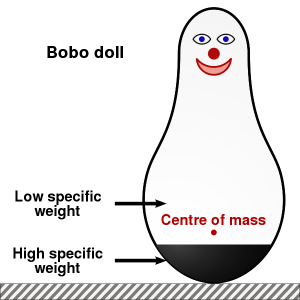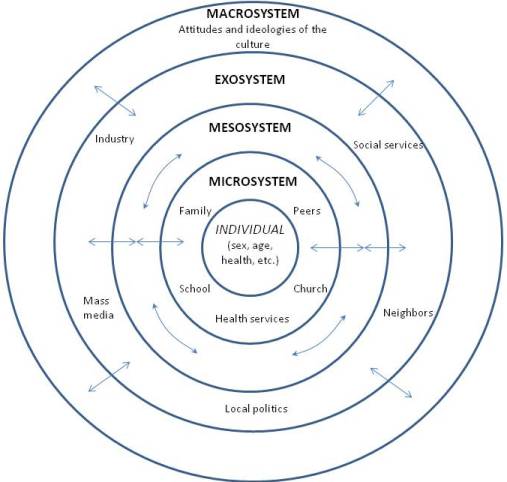2.2 Contemporary Theories on Development
Learning Objectives
- Identify major contemporary theories focusing on lifespan development
- Explain Bronfenbrenner’s Bioecological Theory
As you previously read, there are several meta-theories that underly developmental psychology. These meta-theories are general assumptions that people hold about the nature of humans and the meaning of development, and they influence nearly everything about the field. Meta-theories shape the theories a researcher uses which shapes how one views development. Developmental psychology relies on a systematic approach to understanding behavior, based on observable events and the scientific method. There are so many different observations about childhood, adulthood, and development in general that we use theories to help organize all of the different observable events or variables. A theory is a simplified explanation of the world that attempts to explain how variables interact with each other. It can take complex, interconnected issues and narrow it down to the essentials. This enables developmental theorists and researchers to analyze the problem in greater depth.
People who study lifespan development approach it from different perspectives. Each perspective encompasses one or more theories—the broad, organized explanations and predictions concerning phenomena of interest. Theories of development provide a framework for thinking about human growth, development, and learning. If you have ever wondered about what motivates human thought and behavior, understanding these theories can provide useful insight into individuals and society.
You may be familiar with certain theories of developmental psychology already: Jean Piaget’s theory is one of the most influential in cognitive development, Lev Vygotsky’s theory emphasizes the importance of culture and interaction in the development of cognitive abilities, and Erik Erikson’s psychosocial theory presents eight developmental stages that encompass the entire lifespan. We will discuss these theories in later chapters when we cover these respective domains of development. Here, we will discuss major theoretical frameworks for studying development that apply to several domains.
Learning Theory
Also known as behaviorism, is based on the premise that it is not possible to objectively study the mind, and therefore psychologists should limit their attention to the study of behavior itself. The most famous behaviorist was Burrhus Frederick (B. F.) Skinner (1904–1990), who expanded the principles of behaviorism and also brought them to the attention of the public at large. Skinner used the ideas of stimulus and response, along with the application of rewards or reinforcements, to train pigeons and other animals. In addition, he used the general principles of behaviorism to develop theories about how best to teach children and how to create societies that were peaceful and productive (Skinner, 1957, 1968, 1972).
The behaviorists made substantial contributions to psychology by identifying the principles of learning. Although the behaviorists were incorrect in their beliefs that it was not possible to measure thoughts and feelings, their ideas provided new insights that helped further our understanding regarding the nature-nurture debate as well as the question of free will. The ideas of behaviorism are fundamental to psychology and have been developed to help us better understand the role of prior experiences in a variety of areas of psychology.
Link to Learning
Watch this clip to learn more about operant conditioning and to watch an interview with Skinner as he talks about conditioning pigeons.
You can view the transcript for the B.F. Skinner interview video here (opens in new window).
Social Learning Theory, or learning by watching others, was developed by Albert Bandura (1977). His theory calls our attention to the ways in which many of our actions are not learned through conditioning, as suggested by Skinner. Young children frequently learn behaviors through imitation. Especially when children do not know what else to do, they learn by modeling or copying the behavior of others.

Bandura (1986) suggests that there is interplay between the environment and the individual. We are not just the product of our surroundings, rather we influence our surroundings. There is interplay between our personality and the way we interpret events and how they influence us. This concept is called reciprocal determinism. An example of this might be the interplay between parents and children. Parents not only influence their child’s environment, perhaps intentionally through the use of reinforcement, etc., but children influence parents as well. Parents may respond differently with their first child than with their fourth. Perhaps they try to be the perfect parents with their firstborn, but by the time their last child comes along they have very different expectations, both of themselves and their child. Our environment creates us and we create our environment.
Other social influences: TV or not TV? Bandura, Ross and Ross (1963) began a series of studies to look at the impact of television on the behavior of children. Bandura began by conducting an experiment in which he showed children a film of a woman hitting an inflatable clown or “bobo” doll. Then the children were allowed in the room, where they found the doll and during their play they began to hit it. The children also demonstrated novel ways of being aggressive toward the doll that were not demonstrated by those children who did not see the aggressive model. Bandura’s research raised concerns about the impact of violence on young children. Since then, considerable research has been conducted on the impact of violent media on children’s aggression including playing video games.
Watch It
Watch this clip to better understand Bandura’s research on social learning.
You can view the transcript for “The Bandura Bobo Doll Experiment” here (opens in new window).
Information Processing Theory
Information Processing is not the work of a single theorist, but based on the ideas and research of several cognitive scientists studying how individuals perceive, analyze, manipulate, use, and remember information. This approach assumes that humans gradually improve in their processing skills; that is, cognitive development is continuous rather than stage-like. The more complex mental skills of adults are built from the primitive abilities of children. We are born with the ability to notice stimuli, store, and retrieve information. Brain maturation enables advancements in our information processing system. At the same time, interactions with the environment also aid in our development of more effective strategies for processing information.
Ecological Systems Theory
Urie Bronfenbrenner (1917-2005) developed the Ecological Systems Theory (sometimes referred to as the Bioecological Theory), which provides a framework for understanding and studying the many influences on human development (Bronfenbrenner, 1979). Bronfenbrenner recognized that human interaction is influenced by larger social forces and that an understanding of these forces is essential for understanding an individual. The individual is impacted by several systems including:
- Microsystem includes the individual’s setting and those who have direct, significant contact with the person, such as parents or siblings. The input of those is modified by the cognitive and biological state of the individual as well. These influence the person’s actions, which in turn influence systems operating on him or her.
- Mesosystem includes the larger organizational structures, such as school, the family, or religion. These institutions impact the microsystems just described. The philosophy of the school system, daily routine, assessment methods, and other characteristics can affect the child’s self-image, growth, sense of accomplishment, and schedule thereby impacting the child, physically, cognitively, and emotionally.
- Exosystem includes the larger contexts of community. A community’s values, history, and economy can impact the organizational structures it houses. Mesosystems both influence and are influenced by the exosystem.
- Macrosystem includes the cultural elements, such as global economic conditions, war, technological trends, values, philosophies, and a society’s responses to the global community.
- Chronosystem is the historical context in which these experiences occur. This relates to the different generational time periods previously discussed, such as the baby boomers and millennials.
In sum, a child’s experiences are shaped by larger forces, such as the family, schools, religion, culture, and time period. Bronfenbrenner’s model helps us understand all of the different environments that impact each one of us simultaneously. Despite its comprehensiveness, Bronfenbrenner’s ecological system’s theory is not easy to use. Taking into consideration all the different influences makes it difficult to research and determine the impact of all the different variables (Dixon, 2003). Consequently, psychologists have not fully adopted this approach, although they recognize the importance of the ecology of the individual. Figure 2.5 is a model of Bronfenbrenner’s Ecological Systems Theory.

Watch It
This short video from Professor Rachelle Tannenbaum of Anne Arundel Community College explains and gives examples of Brofenbrenner’s theory.
You can view the transcript for “Bronfenbrenner’s ecological theory” here (opens in new window).
Try It
References (Click to expand)
Bandura, A. (1977). Social learning theory. New York: General Learning Press.
Bandura, A. (1986). Social foundations of thought and action: A social-cognitive theory. Upper Saddle River, NJ: Prentice Hall.
Bandura, A, Ross, D. &. Ross S. (1963). Imitation of film-mediated aggressive models. Journal of Abnormal and Social Psychology, 66, 3-11.
Bronfenbrenner, U. (1979). The ecology of human development: Experiments by nature and design. Cambridge, MA: Harvard University Press.
Skinner, B. (1957). Verbal behavior. Acton, MA: Copley.
Skinner, B. (1968). The technology of teaching. New York, NY: Appleton-Century-Crofts.
Skinner, B. (1972). Beyond freedom and dignity. New York, NY: Vintage Books.
Licenses & Attributions (Click to expand)
CC Licensed Content
- “Lifespan Development: A Psychological Perspective, Second Edition” by Martha Lally and Suzanne Valentine-French is licensed under a CC-BY-NC-SA-3.0
- “What is Development?” by Ellen Skinner, Glen Richardson, Jennifer Pitzer, and Cynthia Taylor, Portland State University is licensed under a CC BY-NC-SA 4.0.
- “Contextual Perspectives” by Sonja Ann Miller for Lumen Learning. Provided by: Lumen Learning. License: CC BY: Attribution
All Rights Reserved Content
- Operant conditioning. Authored by: jenningh. Located at: https://www.youtube.com/watch?v=I_ctJqjlrHA. License: Other. License Terms: Standard YouTube License
- The Bandura Bobo Doll Experiment. Authored by: PsychHub. Located at: https://www.youtube.com/watch?v=Eqxjc4IUDyY. License: Other. License Terms: Standard YouTube License
- Bronfenbrenner ecological theory. Authored by: Rachelle Tannenbaum. Located at: https://www.youtube.com/watch?time_continue=173&v=HV4E05BnoI8. License: Other. License Terms: Standard YouTube License
Media Attributions
- Private: original © Semhur is licensed under a CC BY-SA (Attribution ShareAlike) license
- Private: Bronfenbrenner’s_Ecological_Theory_of_Development_(English) © Hchokr at English Wikipedia is licensed under a CC BY-SA (Attribution ShareAlike) license
